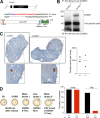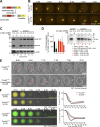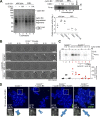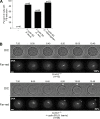Cyclin B3 promotes anaphase I onset in oocyte meiosis
- PMID: 30723090
- PMCID: PMC6446836
- DOI: 10.1083/jcb.201808091
Cyclin B3 promotes anaphase I onset in oocyte meiosis
Abstract
Meiosis poses unique challenges because two rounds of chromosome segregation must be executed without intervening DNA replication. Mammalian cells express numerous temporally regulated cyclins, but how these proteins collaborate to control meiosis remains poorly understood. Here, we show that female mice genetically ablated for cyclin B3 are viable-indicating that the protein is dispensable for mitotic divisions-but are sterile. Mutant oocytes appear normal until metaphase I but then display a highly penetrant failure to transition to anaphase I. They arrest with hallmarks of defective anaphase-promoting complex/cyclosome (APC/C) activation, including no separase activity, high CDK1 activity, and high cyclin B1 and securin levels. Partial APC/C activation occurs, however, as exogenously expressed APC/C substrates can be degraded. Cyclin B3 forms active kinase complexes with CDK1, and meiotic progression requires cyclin B3-associated kinase activity. Cyclin B3 homologues from frog, zebrafish, and fruit fly rescue meiotic progression in cyclin B3-deficient mouse oocytes, indicating conservation of the biochemical properties and possibly cellular functions of this germline-critical cyclin.
© 2019 Karasu et al.
Figures







Similar articles
-
Cyclin B3 activates the Anaphase-Promoting Complex/Cyclosome in meiosis and mitosis.PLoS Genet. 2020 Nov 2;16(11):e1009184. doi: 10.1371/journal.pgen.1009184. eCollection 2020 Nov. PLoS Genet. 2020. PMID: 33137813 Free PMC article.
-
Cyclin B3 is required for metaphase to anaphase transition in oocyte meiosis I.J Cell Biol. 2019 May 6;218(5):1553-1563. doi: 10.1083/jcb.201808088. Epub 2019 Feb 15. J Cell Biol. 2019. PMID: 30770433 Free PMC article.
-
Differential regulation of cyclin B1 degradation between the first and second meiotic divisions of bovine oocytes.Theriogenology. 2012 Oct 1;78(6):1171-81.e1. doi: 10.1016/j.theriogenology.2012.06.006. Epub 2012 Aug 15. Theriogenology. 2012. PMID: 22901768
-
Prophase I arrest and progression to metaphase I in mouse oocytes: comparison of resumption of meiosis and recovery from G2-arrest in somatic cells.Mol Hum Reprod. 2010 Sep;16(9):654-64. doi: 10.1093/molehr/gaq034. Epub 2010 May 7. Mol Hum Reprod. 2010. PMID: 20453035 Free PMC article. Review.
-
Mammalian egg activation: from Ca2+ spiking to cell cycle progression.Reproduction. 2005 Dec;130(6):813-23. doi: 10.1530/rep.1.00710. Reproduction. 2005. PMID: 16322541 Review.
Cited by
-
BPA interferes with granulosa cell development and oocyte meiosis in mouse preantral follicles.Exp Biol Med (Maywood). 2023 Jul;248(13):1145-1158. doi: 10.1177/15353702231179940. Epub 2023 Jul 15. Exp Biol Med (Maywood). 2023. PMID: 37452689 Free PMC article.
-
Alternative cleavage and polyadenylation of the Ccnb1 mRNA defines accumulation of cyclin protein during the meiotic cell cycle.Nucleic Acids Res. 2024 Feb 9;52(3):1258-1271. doi: 10.1093/nar/gkad1151. Nucleic Acids Res. 2024. PMID: 38048302 Free PMC article.
-
Regulation of oocyte maturation: Role of conserved ERK signaling.Mol Reprod Dev. 2022 Sep;89(9):353-374. doi: 10.1002/mrd.23637. Epub 2022 Jul 31. Mol Reprod Dev. 2022. PMID: 35908193 Free PMC article. Review.
-
Mad2 promotes Cyclin B2 recruitment to the kinetochore for guiding accurate mitotic checkpoint.EMBO Rep. 2022 Jun 7;23(6):e54171. doi: 10.15252/embr.202154171. Epub 2022 Apr 5. EMBO Rep. 2022. PMID: 35384228 Free PMC article.
-
Biallelic variant in cyclin B3 is associated with failure of maternal meiosis II and recurrent digynic triploidy.J Med Genet. 2021 Nov;58(11):783-788. doi: 10.1136/jmedgenet-2020-106909. Epub 2020 Sep 16. J Med Genet. 2021. PMID: 32938693 Free PMC article.
References
Publication types
MeSH terms
Substances
Associated data
- Actions
Grants and funding
LinkOut - more resources
Full Text Sources
Medical
Molecular Biology Databases
Miscellaneous

